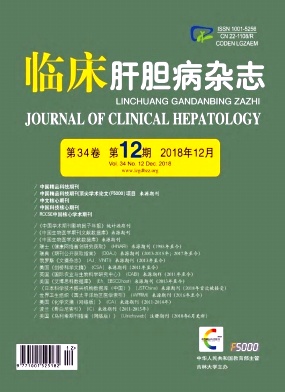|
[1] RINELLA ME. Nonalcoholic fatty liver disease:A systematic review[J]. JAMA, 2015, 313 (22) :2263-2273.
|
|
[2] DIEHL AM, DAY C. Cause, pathogenesis, and treatment of nonalcoholic steatohepatitis[J]. N Engl J Med, 2017, 377 (21) :2063-2073.
|
|
[3] FAN JG, KIM SU, WONG VW. New trends on obesity and NAFLD in Asia[J]. J Hepatol, 2017, 67 (4) :862-873.
|
|
[4] ROTMAN Y, SANYAL AJ. Current and upcoming pharmacotherapy for non-alcoholic fatty liver disease[J]. Gut, 2017, 66 (1) :180-190.
|
|
[5] SANYAL AJ, BRUNT EM, KLEINER DE, et al. Endpoints and clinical trial design for nonalcoholic steatohepatitis[J]. Hepatology, 2011, 54 (1) :344-353.
|
|
[6] SANYAL AJ, FRIEDMAN SL, MCCULLOUGH AJ, et al. Challenges and opportunities in drug and biomarker development for nonalcoholic steatohepatitis:Findings and recommendations from an American Association for the Study of Liver Diseases-U. S. Food and Drug Administration Joint Workshop[J]. Hepatology, 2015, 61 (4) :1392-1405.
|
|
[7] CAUSSY C, REEDER SB, SIRLIN CB, et al. Noninvasive, quantitative assessment of liver fat by MRI-PDFF as an endpoint in NASH trials[J]. Hepatology, 2018, 68 (2) :763-772.
|
|
[8] NEUSCHWANDER-TETRI BA, LOOMBA R, SANYAL AJ, et al. Farnesoid X nuclear receptor ligand obeticholic acid for noncirrhotic, non-alcoholic steatohepatitis (FLINT) :A multicentre, randomised, placebo-controlled trial[J]. Lancet, 2015, 385 (9972) :956-965.
|
|
[9] NALBANTOGLU IL, BRUNT EM. Role of liver biopsy in nonalcoholic fatty liver disease[J]. World J Gastroenterol, 2014, 20 (27) :9026-9037.
|
|
[10] VIOLI F, CANGEMI R. Pioglitazone, vitamin E, or placebo for nonalcoholic steatohepatitis[J]. N Engl J Med, 2010, 363 (12) :1185-1186.
|
|
[11] FRIEDMAN S, SANYAL A, GOODMAN Z, et al. Efficacy and safety study of cenicriviroc for the treatment of non-alcoholic steatohepatitis in adult subjects with liver fibrosis:CENTAUR Phase 2b study design[J]. Contemp Clin Trials, 2016, 47:356-365.
|
|
[12] SANYAL AJ, MOFRAD PS, CONTOS MJ, et al. A pilot study of vitamin E versus vitamin E and pioglitazone for the treatment of nonalcoholic steatohepatitis[J]. Clin Gastroenterol Hepatol, 2004, 2 (12) :1107-1115.
|
|
[13] NEUSCHWANDER-TETRI BA, BRUNT EM, WEHMEIER KR, et al. Improved nonalcoholic steatohepatitis after 48 weeks of treatment with the PPAR-gamma ligand rosiglitazone[J]. Hepatology, 2003, 38 (4) :1008-1017.
|
|
[14] BRUNT EM, JANNEY CG, DI BISCEGLIE AM, et al. Nonalcoholic steatohepatitis:A proposal for grading and staging the histological lesions[J]. Am J Gastroenterol, 1999, 94 (9) :2467-2474.
|
|
[15] KLEINER DE, BRUNT EM, van NATTA M, et al. Design and validation of a histological scoring system for nonalcoholic fatty liver disease[J]. Hepatology, 2005, 41 (6) :1313-1321.
|
|
[16] BEDOSSA P. FLIP Pathology Consortium. Utility and appropriateness of the fatty liver inhibition of progression (FLIP) algorithm and steatosis, activity, and fibrosis (SAF) score in the evaluation of biopsies of nonalcoholic fatty liver disease[J]. Hepatology, 2014, 60 (2) :565-575.
|
|
[17] BEDOSSA P, POITOU C, VEYRIE N, et al. Histopathological algorithm and scoring system for evaluation of liver lesions in morbidly obese patients[J]. Hepatology, 2012, 56 (5) :1751-1759.
|
|
[18] ALKHOURI N, de VITO R, ALISI A, et al. Development and validation of a new histological score for pediatric non-alcoholic fatty liver disease[J]. J Hepatol, 2012, 57 (6) :1312-1318.
|
|
[19] European Association for the Study of the Liver (EASL) ; European Association for the Study of Diabetes (EASD) ; European Association for the Study of Obesity (EASO) . EASL-EASD-EASD Clinical Practice Guidelines for the management of nonalcoholic fatty liver disease[J]. J Hepatol, 2016, 64 (6) :1388-1402.
|
|
[20] YOUNOSSI ZM, GRAMLICH T, LIU YC, et al. Nonalcoholic fatty liver disease:Assessment of variability in pathologic interpretations[J]. Mod Pathol, 1998, 11 (6) :560-565.
|
|
[21] BEDOSSA P, CARRAT F. Liver biopsy:The best, not the gold standard[J]. J Hepatol, 2009, 50 (1) :1-3.
|
|
[22] ROCKEY DC, CALDWELL SH, GOODMAN ZD, et al. Liver biopsy[J]. Hepatology, 2009, 49 (3) :1017-1044.
|
|
[23] LARSON SP, BOWERS SP, PALEKAR NA, et al. Histopathologic variability between the right and left lobes of the liver in morbidly obese patients undergoing Roux-en-Y bypass[J]. Clin Gastroenterol Hepatol, 2007, 5 (11) :1329-1332.
|
|
[24] YANG M, XU D, LIU Y, et al. Combined serum biomarkers in non-invasive diagnosis of non-alcoholic steatohepatitis[J]. PLo S One, 2015, 10 (6) :e0131664.
|
|
[25] YOUNOSSI ZM, LOOMBA R, ANSTEE QM. Diagnostic modalities for nonalcoholic fatty liver disease, nonalcoholic steatohepatitis, and associated fibrosis[J]. Hepatology, 2018, 68 (1) :349-360.
|
|
[26] CHEAH MC, MCCULLOUGH AJ, GOH GB. Current modalities of fibrosis assessment in non-alcoholic fatty liver disease[J]. J Clin Transl Hepatol, 2017, 5 (3) :261-271.
|
|
[27] MAIDA M, MACALUSO FS, SALOMONE F, et al. Non-invasive assessment of liver injury in non-alcoholic fatty liver disease:A review of literature[J]. Curr Mol Med, 2016, 16 (8) :721-737.
|
|
[28] VILAR-GOMEZ E, CHALASANI N. Non-invasive assessment of non-alcoholic fatty liver disease:Clinical prediction rules and blood-based biomarkers[J]. J Hepatol, 2018, 68 (2) :305-315.
|







 DownLoad:
DownLoad: